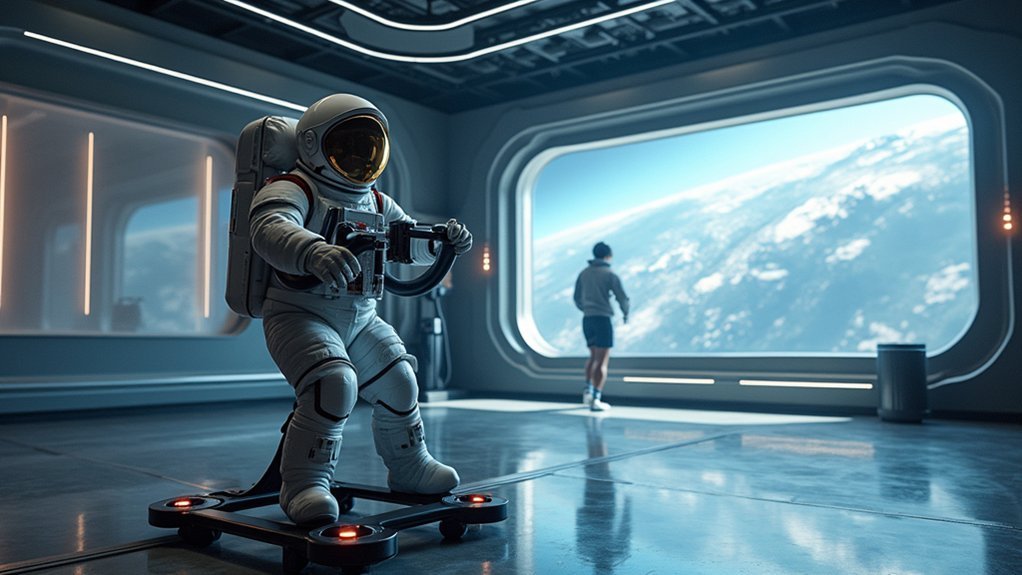NASA prioritizes three key exercises for astronaut skeletal health: the ARED resistance device that mimics Earth’s weight training, treadmill running with a specialized harness system for weight-bearing benefits, and vibration platforms that deliver targeted oscillations to stimulate bone remodeling. Together, these exercises can reduce monthly bone loss from potentially devastating levels to just 1-2% during space missions. These techniques form the backbone of NASA’s approach to keeping astronauts mission-ready.
ARED: NASA’s Advanced Resistance Exercise Device for Bone Maintenance

While astronauts float weightlessly in space, their bones face a serious threat of deterioration. NASA’s Advanced Resistance Exercise Device (ARED) directly combats this challenge by simulating Earth’s weight-bearing exercises in microgravity.
ARED enables astronauts to perform critical movements like squats, deadlifts, and bench presses that place controlled stress on bones. This mechanical stress is important for maintaining bone density during long missions. The device’s adjustable resistance mimics free weights, providing the force needed to stimulate bone maintenance.
Research shows ARED considerably reduces bone loss, limiting monthly bone mineral density reduction to just 1-2% compared to higher rates without exercise.
As NASA prepares for Mars missions, ARED remains essential to their skeletal health countermeasures, helping astronauts maintain the bone strength they’ll need upon returning to Earth.
Treadmill Running With Harness System: Simulating Earth’s Gravity
In addition to resistance training, NASA employs another key strategy to combat bone loss during space missions. Treadmill running with a specialized harness system allows astronauts to simulate gravity while in microgravity environments. This innovative setup secures you to the treadmill, enabling weight-bearing exercises despite the absence of gravitational force.
You’ll need to dedicate approximately two hours daily to this regimen, as studies show it considerably reduces bone mineral density deterioration—which can reach 1-2% monthly in space. The harness creates the downward force necessary to stress your skeletal system, mimicking Earth’s conditions.
For ideal skeletal health during long-duration space missions, NASA combines treadmill sessions with resistance exercises, creating a thorough workout protocol that effectively counters the adverse effects of extended microgravity exposure.
Vibration Platforms: How NASA Uses Targeted Oscillation for Bone Stimulation

Beyond traditional resistance training, NASA has pioneered the use of vibration platforms as a cutting-edge solution to combat bone loss in microgravity. These specialized platforms deliver precise oscillations that stimulate your skeletal health by mimicking the mechanical stress bones naturally experience on Earth.
When you’re an astronaut floating in space, your bones don’t receive the loading they need, putting you at risk for accelerated bone mineral density loss. Vibration therapy counteracts bone loss by triggering the remodeling process essential for maintaining strength.
Studies show incorporating these platforms into astronauts’ exercise regimens markedly reduces the risk of osteoporosis and fractures upon returning to Earth. This innovative approach provides a vital supplement to traditional exercises, especially when weight-bearing activities are difficult to perform in the unique constraints of space travel.
Frequently Asked Questions
What Is NASA Most Effective Exercise?
NASA’s most effective exercise is specialized treadmill training with restraints that simulates weight-bearing activity. You’ll also benefit from resistance training using the ARED, where you can perform squats and lifts to maintain bone density.
What Are the Best Exercises for the Skeleton?
For your skeleton’s health, you’ll benefit most from weight-bearing exercises like walking or jogging, resistance training with weights, and balance-improving activities such as yoga. These combat bone density loss and strengthen your skeletal structure.
How Do Astronauts Regain Bone Density?
After returning to Earth, you’ll regain bone density through weight-bearing exercises, resistance training, and nutrition rich in calcium and vitamin D. Your body gradually rebuilds bone mass in Earth’s gravity over several months.
What Type of Exercises Are Best for Improving Bone Health Why?
Weight-bearing and resistance exercises are best for your bone health. You’ll strengthen bones through activities like walking, jogging, and weightlifting because they create mechanical stress that stimulates bone formation and remodeling.
In Summary
You’ve now discovered NASA’s top methods for maintaining skeletal strength in low-gravity environments. Whether you’re incorporating ARED resistance training, harnessed treadmill running, or vibration platform therapy into your routine, you’re adopting space-tested solutions. These exercises don’t just benefit astronauts—they’re valuable for anyone looking to preserve bone density, especially as you age. Apply these NASA-developed techniques to keep your skeletal system strong for years to come.




Leave a Reply